2nd Part
ANCIENT JEWELLERY EXHIBITED IN ANATOLIAN CIVILIZATIONS MUSEUM
Neck Jewellery
Necklaces
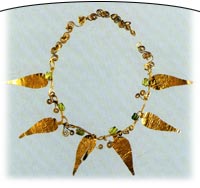 | Name: | Necklace |
| Type: | Gold and krizoprase |
| Location where it came from: | Eastern Anatolian |
| Way of Coming: | Purchase |
| Weight: | 15.1 gr |
| Period | The Urartu Period |
The ends of the long, golden wires are twisted in oval shape and one eye is formed at each end. The ends of first one and then the second of these eyes are surrounded with a thinner second wire and closed. There is one golden leaf attached to a golden wire from their handles between the two eyes of these elements which are six pieces and which form the front side of a necklace. There is one krisoprase in the middle of the thin wires and there are "S" spiral ornaments between the leaves. The neck (back) side of the chain is formed by connecting similar "S" spiral elements to each other. A hook and a ring system necessary for closing the chain is broken,
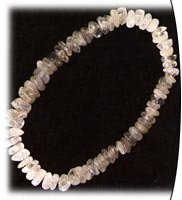 | Name: | Necklace |
| Type: | Quartz |
| Location where it came from: | Batman |
| Way of Coming: | Purchase |
| Dimensions:: | L:32cm |
| Weight: | 2.5 gr. |
| Period: | Ancient Bronze |
The middle of the bead pieces that are irregularly cut and carved are holed. The crystal structure of the quartz crystal is deformed.
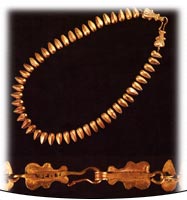 | Name: | Necklace with clips |
| Type: | Altın |
| Location where it came from: | Tokat, Darıdere |
| Way of Coming: | Purchase |
| Dimensions:: | piece L:1.2cm W:0.6cm |
| Weight: | 28.2 gr. |
| Period: | The 6-5th century BC |
It is really an opus. 48 elements, where one face is flat, almond shaped, the middle of the front faces of which are sheathed, are brought aside and are combined with each other with thin golden wire rings. The holes on the flat rear sides of these elements made with a mould technique are the holes used for discharging the internal mould. The necklace ends with a hook connected to a stylized palmet motif on both ends and a loop.
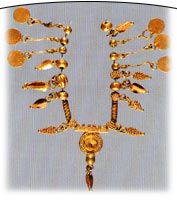 | Name: | Necklace elements |
| Type: | Gold |
| Location where it came from: | Sarayköy |
| Way of Coming: | Confiscation |
| Dimensions:: | L: 6.5 cm |
| Weight: | 5.48 gr. |
| Period: | The 5th century BC |
It is a new arrangement in which six pendulums are brought together. On one end of the golden wire where both ends are hooked, there is a thin, flat, round scale; it is passed through a ring attached to the chain on the other end. A granule cocoon connected to a granule bead through the hole in the middle, with three small rings and a three winged leaf at the end of which there is a single granule particle (6 pieces, one of them is connected with a thin, round scale having a band of granule particles around); a twisted small pipe formed by winding a thin golden band (2 pieces), the small pipe in which the triangles formed by granule spheres and a single golden flat small pipe are brought aside. Granulation, cutting, twisting and gold welding techniques are applied.
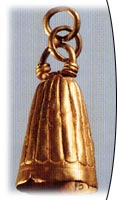 | Name: | Necklace element |
| Type: | Gold |
| Location where it came from: | Yozgat |
| Way of Coming: | Not known |
| Dimensions:: | H:2.3cm W:1.2cm |
| Weight: | 3.1 gr |
| Period: | The 4th century BC |
It is in a form of a bell and its upper part is grooved. The ends of a ring at the top of it are closed being wound over each other. Round profiled rings that are closed with solder form the chain part of a necklace or the intermediate rings providing a connection to a chain.
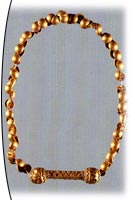 | Name: | Necklace |
| Type: | Gold |
| Location where it came from: | Yozgat |
| Way of Coming: | Not known |
| Dimensions:: | piece D:0.4cm |
| Weight: | 2.2 gr (total) |
| Period: | The 4th century BC |
A pipe made of golden sheet is ornamented with granule triangles and the places where the golden balls connect with the pipe, the perimetre of string passage hole are granule ornamented. Small knobs are semi - round, their single rings are on the back. They can not be necklace particles. They are formed as a necklace here. Their diametres are 0.4 cm. Knobs similar to those knobs are found in Maikop (Caucasia), and they have been recorded into literature as a new type.
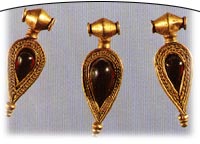 | Name: | Necklace element |
| Type: | Gold and grena |
| Location where it came from: | Karaoğlan |
| Way of Coming: | Not known |
| Dimensions:: | H:3.5cm W:0.5cm |
| Weight: | 10 gr (total) |
| Period: | The Hellenistic Period |
The hammer formed, wide string ring is soldered to a leaf shaped pandantive through a profiled, round, high neck. The back of the pandantive is a flat golden sheet. The front face is placed between two flat filigrees. A golden wire starting from the bracelet of the neck and passing through the pandantive vertically is twisted three times at the lower side and forms the end of the leaf.